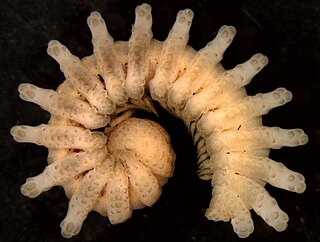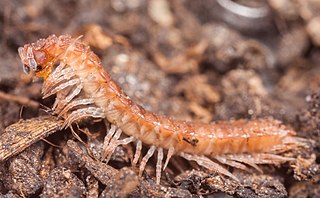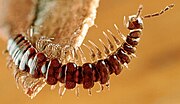
Millipedes are a group of arthropods that are characterised by having two pairs of jointed legs on most body segments; they are known scientifically as the class Diplopoda, the name derived from this feature. Each double-legged segment is a result of two single segments fused together. Most millipedes have very elongated cylindrical or flattened bodies with more than 20 segments, while pill millipedes are shorter and can roll into a tight ball. Although the name "millipede" derives from Latin for "thousand feet", no species was known to have 1,000 or more until the discovery in 2020 of Eumillipes persephone, which can have over 1,300 legs. There are approximately 12,000 named species classified into 16 orders and around 140 families, making Diplopoda the largest class of myriapods, an arthropod group which also includes centipedes and other multi-legged creatures.

Harpaphe haydeniana, commonly known as the yellow-spotted millipede, almond-scented millipede or cyanide millipede, is a species of polydesmidan ("flat-backed") millipede found in the moist forests along the Pacific coast of North America, from Southeast Alaska to California, and Thailand .The dark coloration with contrasting yellow-tipped keels warn of its ability to exude toxic hydrogen cyanide as a defense. The cyanide secretions are not dangerous to humans, but can cause irritation and pain if it contacts sensitive areas such as the mouth, eyes, or nose.

Xystodesmidae is a family of millipedes. Its members often have very small distributional areas, with many species only known from a single locality. They are found across the northern hemisphere, with peak diversity in the Appalachian Mountains, where one-third of the 300 or so species occur. They are particularly abundant in deciduous broadleaf forests in the Mediterranean Basin, Africa, Asia, Central and North America, and Russia. Information on basic taxonomy is scant for this family; for example, it is estimated that the genus Nannaria contains over 200 species, but only 25 were described as of 2006. By 2022, 78 species in Nannaria have been described.
Tridontomidae is a small family of millipedes. Its members are endemic to Guatemala. These millipedes range from 22 mm to 28 mm in length and are uniformly grayish in color; their legs and antennae are unusually long and slender. This family includes the remarkable species Aenigmopus alatus, in which adult males feature no gonopods. This millipede is the only species in the infraclass Helminthomorpha without gonopods.

Julida is an order of millipedes. Members are mostly small and cylindrical, typically ranging from 10–120 millimetres (0.39–4.72 in) in length. Eyes may be present or absent, and in mature males of many species, the first pair of legs is modified into hook-like structures. Additionally, both pairs of legs on the 7th body segment of males are modified into gonopods.

Orthomorpha is a genus of millipedes in the family Paradoxosomatidae containing approximately 50 species distributed in Southeast Asia.

Chordeumatida is a large order of millipedes containing some 1200 species with a nearly worldwide distribution. Also known as sausage millipedes, they grow and develop through a series of moults, adding segments until they reach a fixed number in the adult stage, which is usually the same for a given sex in a given species, at which point the moulting and the addition of segments and legs stop. This mode of development, known as teloanamorphosis, distinguishes this order from most other orders of millipedes, which usually continue to moult as adults, developing through either euanamorphosis or hemianamorphosis.

Casimir Albrecht Willem Jeekel (1922–2010) was a Dutch myriapodologist and entomologist known for his major contributions to the taxonomy of millipedes. His 1971 monograph Nomenclator Generum et Familiarum Diplopodorum is credited as launching the "modern era" of millipede taxonomy, and has been considered the "most important single work ever published on the Diplopoda". He served as director of the Zoological Museum Amsterdam, and authored over 150 works on the taxonomy of millipedes and other myriapods.

Platyrhacidae is a family of polydesmidan millipedes distributed in Southeast Asia and tropical Central and South America.

Haplodesmidae is a family of millipedes in the order Polydesmida. Species occur in East Asia, Southeast Asia, and Oceania, although some species have been introduced to the New world tropics. Species are small bodied, often with elaborate sculpturing on the tergites, and some species are capable of rolling into a near-complete ball.

Ammodesmidae is a family of small millipedes endemic to Africa, containing seven species in two genera. Ammodesmids range from 1.4 to 5.0 mm long with 18 or 19 body segments in both sexes, and are capable of rolling into a tight sphere.

Metopidiotrichidae is a family of millipedes in the order Chordeumatida. These millipedes range from 4 mm to 17 mm in length. Adult millipedes in this family have 32 segments, not the 30 segments usually found in this order. Adult males in this family often feature a reduced or vestigial leg pair 10 as part of the gonopod complex, in addition to the two leg pairs typically modified into gonopods in this order. There are about 9 genera and at least 70 described species in Metopidiotrichidae.

Brachydesmus is a genus of millipedes belonging to the family Polydesmidae. Millipedes in this genus are found mainly in Europe. Species in this genus have only 19 segments as adults, one fewer than found in most polydesmid species. Accordingly, adults in this genus have two fewer legs than most polydesmid adults have: Females have only 29 pairs of legs, and males have only 28 pairs of walking legs, excluding one pair of gonopods. Species in this genus arrive at these lower numbers of legs and segments by going through the same stages of teloanamorphosis observed in other polydesmids but reaching maturity one moult earlier.
Trichopolydesmidae is a family of millipedes belonging to the order Polydesmida. This family includes two genera notable for featuring sexual dimorphism in segment number: adult females in these genera have the 20 segments usually found in this order, but adult males have only 19. This family also includes the species Deharvengius bedosae, notable for being among the very few species in this order to feature adults with only 18 segments rather than the 20 segments usually found in polydesmids.
Chordeumatidae is a family of millipedes belonging to the order Chordeumatida. These millipedes range from 7 mm to 18 mm in length and are found in Europe. Adult millipedes in this family have either 28 or 30 segments. This family features distinctive sex-linked modifications to the legs in adults: In the adult female, a legless sternite replaces the third pair of legs, and in the adult male, five pairs of legs are modified in the gonopod complex. These modifications are more extensive than those found in other adult males in this order, which often have only two leg pairs modified into gonopods. With the more extensive modifications to the legs in this family, species with the usual 30 segments feature adult females with only 49 leg pairs and adult males with only 45 pairs of walking legs, and species with only 28 segments feature adult females with only 45 leg pairs and adult males with only 41 pairs of walking legs.
Haaseidae is a family of millipedes belonging to the order Chordeumatida. Adult millipedes in this family range from 4.5 mm to 12 mm in length and have either 28 or 30 segments. For example, Orobainosoma hungaricum orientale, a subspecies of Haasea hungarica, has only 28 segments in adults rather than the 30 usually found in chordeumatidan adults, with only 46 pairs of legs in adult females and only 44 pairs of walking legs in adult males.
Hoffmaneumatidae is a family of millipedes belonging to the order Chordeumatida. This family includes two genera, one (Hoffmaneuma) found in the Russian Far East and the other (Japanoparvus) found in Japan. Millipedes in this family range from 4 mm to 6 mm in length. Adult millipedes in this family have only 28 segments, not the 30 segments usually found in this order. Adult males in this family feature a reduced leg pair 10 in addition to the two pairs normally modified into gonopods in this order. In the adult male of the species Hoffmaneuma exiguum, for example, the gonopod complex derives from all three leg pairs rather than from just the usual two.
Trachygonidae is a family of millipedes belonging to the order Chordeumatida. Adult millipedes in this family have 28 or 30 segments.
Opisthocheiridae is a family of millipedes belonging to the order Chordeumatida. These millipedes range from 5 mm to 16 mm in length and are found from Belgium to Morocco. Adult millipedes in this family have 26 or 30 segments. This family includes the cave-dwelling species Opisthocheiron canayerensis, notable as one of few chordeumatidan species with only 26 segments. The adult female of this species has only 42 pairs of legs, and the adult male has only 40 leg pairs, as one would expect for adult chordeumatidans with four fewer segments than typically found in this order.
Glomeridellidae is a family of millipedes belonging to the order Glomerida. The adult males in this family have two pairs of telopods rather than the single pair found in other families in this order.




















